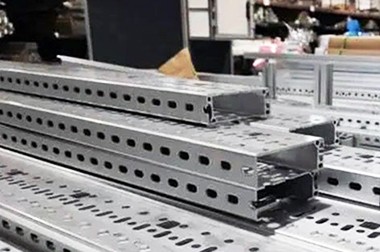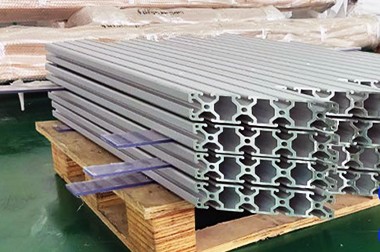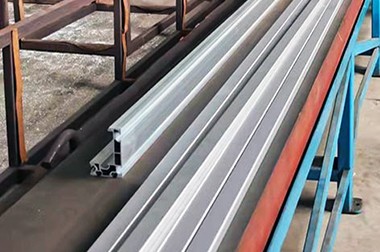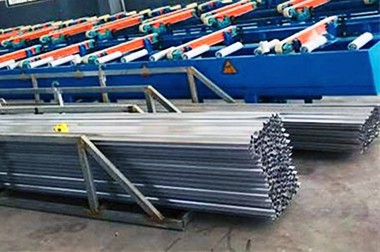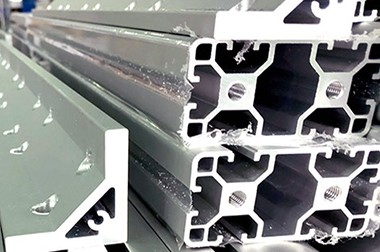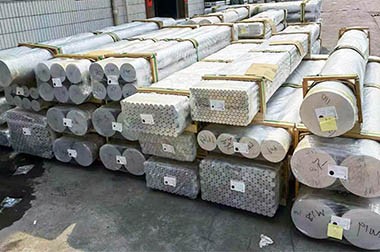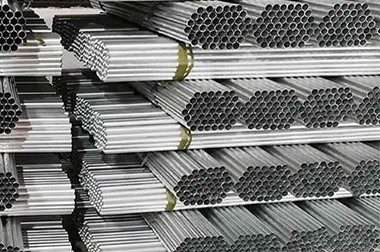2014 Aerospace Aluminum Extrusion Profile
Haomei Aluminum produces aerospace-grade aluminum extrusions according to specifications such as AMS 4153, ASTM-B221, UNS A92014, QQ-A-200/2, etc.
Aluminum 2014 is a precipitation-hardened alloy with good corrosion resistance, high electrical conductivity, and excellent machinability. As one of the strongest aluminum alloys on the commercial market, 2014A aluminum is widely used in the manufacture of aircraft and truck components as well as forging.
Characteristics of 2014 Aerospace Aluminum Extrusions
1. Strength
2014 aluminum alloy can achieve higher strength through appropriate heat treatment, making it an ideal choice for aerospace structural components such as wings, fuselages, and other load-bearing parts capable of withstanding high loads and stresses during flight.
2. Wear Resistance
Due to its high hardness and excellent fatigue strength, 2014 aluminum alloy performs well in high-impact and wear environments. It is commonly used to manufacture high-friction mechanical parts, such as gears, bearings, and guide rails, effectively extending service life.
3. Weldability
While the weldability of 2014 aluminum alloy is relatively good, the strength of the welded area may decrease during the welding process. Therefore, selecting the appropriate welding process and filler materials is crucial. In some cases, post-weld heat treatment may be required to restore strength.
4. Corrosion Resistance
The corrosion resistance of 2014 aluminum alloy is particularly prominent after treatments, such as anodizing or coating, which can enhance its corrosion resistance. This characteristic allows it to maintain good performance even in humid or corrosive environments.
5. Machinability
After extrusion, 2014 aluminum alloy has good machinability. It can be processed through cutting, milling, drilling, and other methods. However, it is important to control temperature during processing to avoid changes in hardness and material damage.
6. Heat Treatment
2014 aluminum alloy can significantly enhance its mechanical properties through different heat treatment processes (such as T6 treatment). Heat treatment can increase the material's strength and hardness, making it suitable for high-strength aerospace applications.
2014 Aluminum Extrusion Specifications
Currently Offering To The Following Specifications:
AMS-4153
ASTM-B221
Latest Designation: AMS-QQ-A200/2
Other Specifications: ABS, ASNA, LN, Werkstoff, NTA, DAN, AIR
Chemical composition of Haomei 2014 aerospace aluminum alloy
| Chemical Element | % Present |
| Si | 0.15-1.2 |
| Fe | 0.7 |
| Cu | 3.9-5.0 |
| Mn | 0.40-1.2 |
| Mg | 0.20-0.8 |
| Ti | 0.15 |
| Cr | 0.10 |
| Zn | 0.25 |
| Other (Each) | 0.0-0.05 |
| Aluminium (Al) | Balance |
Mechanical properties of Haomei 2014 aerospace high quality extrusion
| Density | 2.8g/cm3 (0.1018lb/in3) |
| Young's modulus | 73 Gpa (11 Msi) |
| Electrical conductivity | 34% to 50% IACS |
| Ultimate tensile strength | 190-480 Mpa (28-70 ksi) |
| Thermal conductivity | 130-190 W/m-K |
| Thermal expansion | 23 μm/m-K |
| Poisson's ratio | 0.33 |
| Melting point | 510C / 950F |
2014 Aerospace Aluminum Extrusion Profile Type
2014 Aluminum Round Tube
- Features: High strength-to-weight ratio, excellent machinability, and good corrosion resistance. It typically has a tensile strength of around 430 MPa.
- Processing: Extruded to achieve uniform wall thickness and diameter. Often used in structural applications where strength is critical.
- Application: Used in aircraft fuselage frames and support structures, as well as in landing gear components.
2014 Aluminum Square Tube
- Features: Offers similar strength and machinability as the round tube but with added rigidity. Suitable for structural applications due to its shape.
- Processing: Extruded to specific dimensions and cut to length, ensuring precise tolerances.
- Application: Commonly found in aircraft frames, cargo supports, and other structural elements where square profiles provide better load distribution.
2014 Aluminum Rectangular Tube
- Features: Provides strength in two directions, making it ideal for load-bearing applications. It has a good balance of ductility and strength.
- Processing: Similar extrusion process as other tubes, often with additional machining for specific applications.
- Application: Used in fuselage structures, cargo handling systems, and support frameworks.
2014 Aluminum Angle
- Features: Excellent strength and rigidity. Available in various leg lengths and thicknesses. Good for reinforcement applications.
- Processing: Typically extruded or rolled into shape. Edges can be machined for precise fitment.
- Application: Used in airframe structures and as brackets for attaching components in aircraft assembly.
2014 Aluminum T-Profile
- Features: Combines strength with versatility. The T-shape allows for efficient load transfer in multiple directions.
- Processing: Extruded and often cut to size. Machining may be done to fit specific assembly requirements.
- Application: Useful in aircraft frames and mounting brackets where a T-section can distribute loads effectively.
2014 Aluminum U-Profile
- Features: Good bending and shear strength. Its U-shape provides an effective method for connecting parts or channels.
- Processing: Extruded and then often machined or treated for specific applications.
- Application: Commonly used in rail systems, guide rails, and structural reinforcements in aircraft.
2014 Extruded Aluminum Round Bar
- Features: High strength with excellent machinability. Used for manufacturing components that require significant strength.
- Processing: Extruded to create bars of various diameters, followed by cutting and machining as necessary.
- Application: Utilized in engine components, fasteners, and other critical structural parts.
2014 Extruded Aluminum Square Bar
- Features: Provides enhanced rigidity and is easy to machine. Excellent surface finish.
- Processing: Extruded to specific dimensions, often followed by precise machining.
- Application: Used in aircraft fittings, connectors, and brackets where a square profile enhances load-bearing capability.
2014 Extruded Aluminum Flat Bar
- Features: Versatile and strong, can be used for a variety of applications. Available in various thicknesses and widths.
- Processing: Extruded and machined to meet specific application requirements.
- Application: Often used for structural components, spacers, and as part of assembly fixtures in aircraft.
2014 Extruded Aluminum Hexagonal Bar
- Features: Unique shape allows for creative engineering solutions. Maintains strength while providing a distinctive design.
- Processing: Extruded into hexagonal shapes, then typically machined or cut to length.
- Application: Used in specialized fittings, connectors, and custom parts in aircraft systems.
Heat Treatment of 2014 Aerospace Aluminum Extrusion Profile
2014 aluminum alloy is typically aged to enhance its mechanical properties. Common heat treatment states include:
- T4 (Solution treated and naturally aged)
- T6 (Solution treated and artificially aged)
Machining Characteristics of 2014 Aerospace Aluminum Extrusion Profile
- Extrusion: 2014 aluminum alloy is easy to extrude, allowing for the manufacture of complex profiles and cross-sections.
- Weldability: Weldability is relatively poor and often requires specialized welding techniques, such as using filler materials for welding aluminum alloys.
Aerospace Aluminum Extrusion Profile Typical Alloys
- 2014 Aluminum Extrusion Profile
- 2024 Aluminum Extrusion Profile
- 2618 Aluminum Extrusion Profile
- 5083 Aluminum Extrusion Profile
- 6061 Aluminum Extrusion Profile
- 6082 Aluminum Extrusion Profile
- 7075 Aluminum Extrusion Profile
- 7150 Aluminum Extrusion Profile
- 7178 Aluminum Extrusion Profile
2000 Series Aluminum Alloy Profile
| Aluminum Alloy Products | Applications |
| 2014 Aluminum Alloy Extrusion Profiles | 2014 aluminum alloy can be used in applications requiring high strength, high hardness, and high temperature resistance, suitable for aerospace materials, forgings, thick plates, extrusion materials, wheels, structural components, spacecraft parts, first fuel tanks of multi-stage rockets, truck frames, suspension components, etc. |
| 2219 Aluminum Alloy Extrusion Profiles | 2219 aluminum alloy can be used for oxidizer tanks in space shuttles, skin and structural components of supersonic aircraft. It has a usage temperature range of -270 to 300°C, with good welding performance and high fracture toughness. In T8 condition, the alloy exhibits excellent resistance to stress corrosion cracking. |
| 2618 Aluminum Alloy Extrusion Profiles | 2618 aluminum alloy can be used to manufacture forgings and impact-forged components, as well as pistons and parts for aircraft engines. |
| 2A50 Aluminum Alloy Extrusion Profiles | 2A50 aluminum alloy is used to manufacture complex-shaped, high-strength components. |
| 2A70F Aluminum Alloy Extrusion Profiles | 2A70F aluminum alloy is used to manufacture aircraft skins, aircraft engines, pistons, guide wheels, and discs. |



